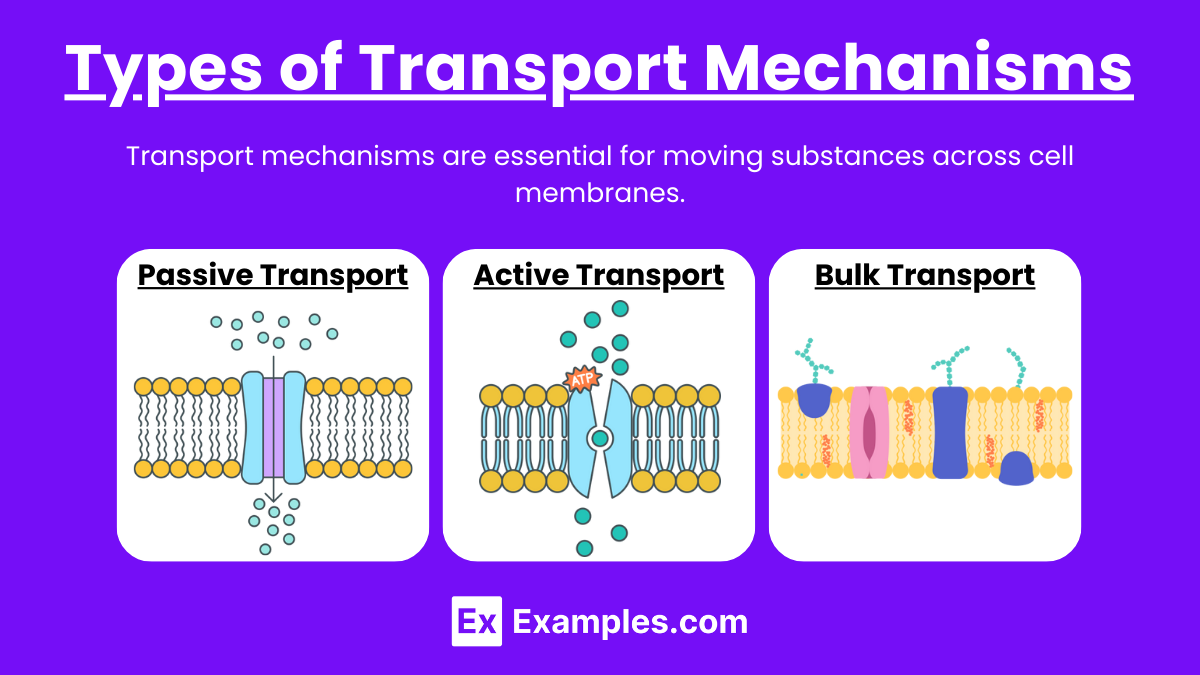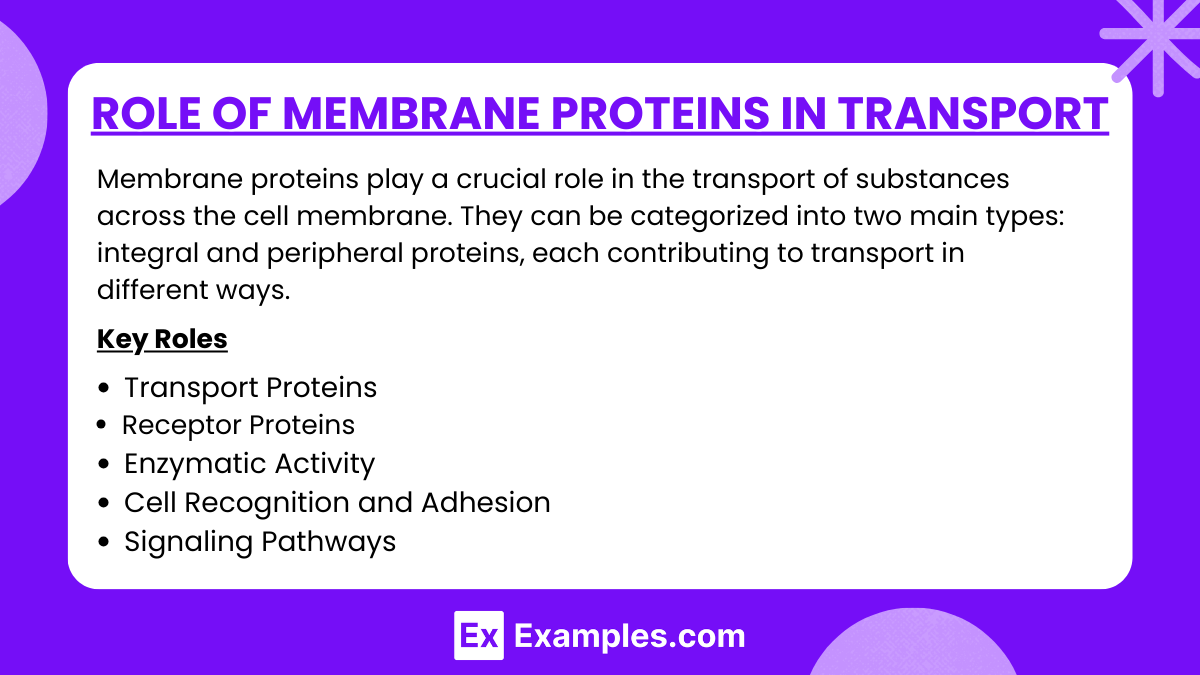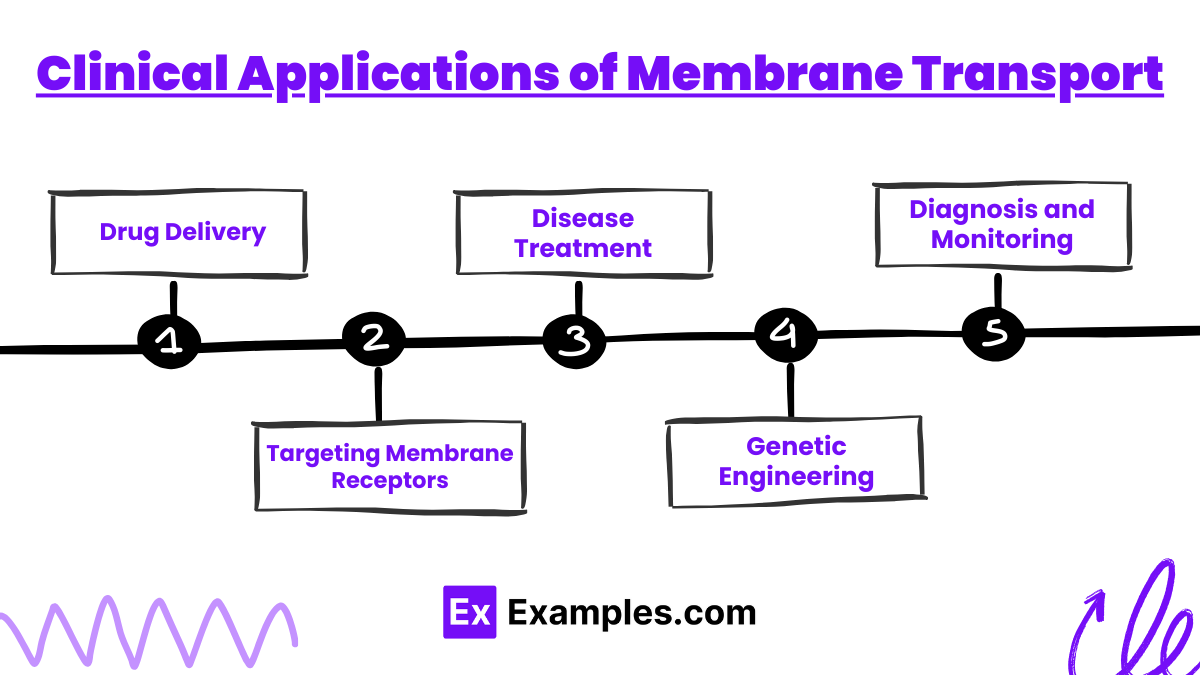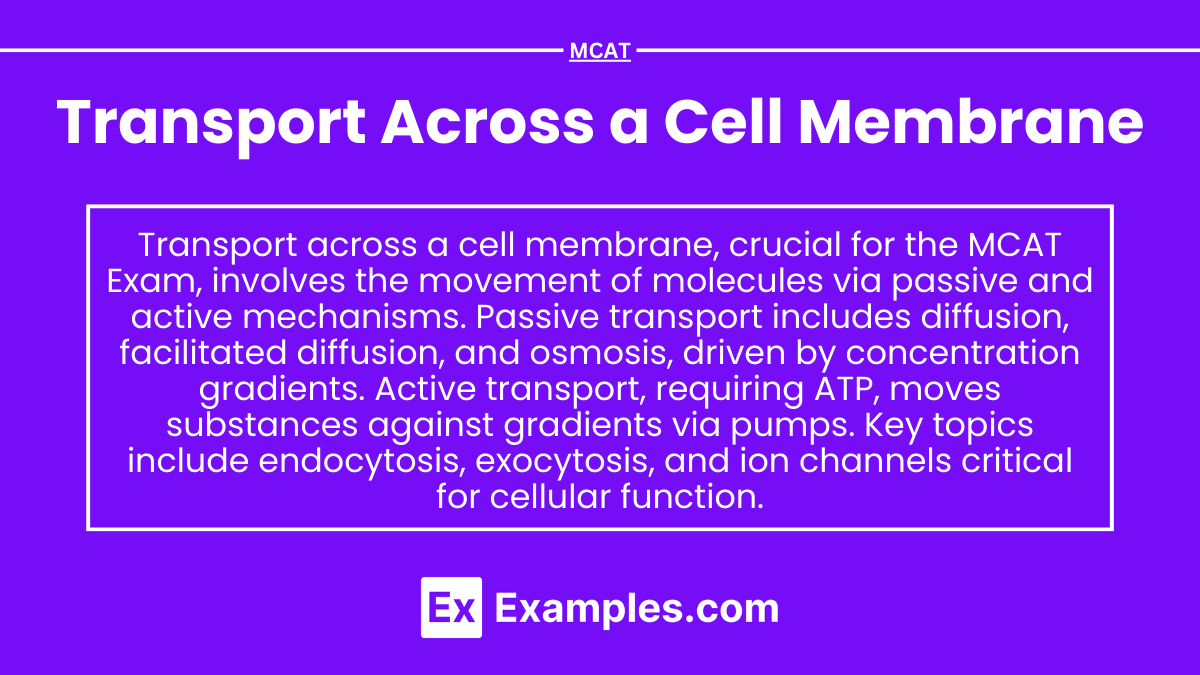Preparing for the MCAT requires a comprehensive understanding of transport across the cell membrane, a vital topic within the Cells foundation. Mastery of passive and active transport mechanisms, including diffusion, osmosis, and protein pumps, is essential. This knowledge is crucial for understanding cellular function, homeostasis, and signaling, key to achieving a high MCAT score.
Learning Objective
In studying “Transport Across a Cell Membrane” for the MCAT, you should understand the mechanisms by which substances move across cell membranes, including passive transport (diffusion, facilitated diffusion) and active transport (primary and secondary). Analyze the role of membrane proteins, such as channels and pumps, in regulating these processes. Evaluate how factors like concentration gradients, membrane permeability, and osmotic pressure influence transport dynamics. Additionally, explore the significance of transport in physiological contexts, such as nutrient uptake and waste removal, and apply your knowledge to interpret experimental data and scenarios in MCAT practice passages.
Introduction to Membrane Transport

Membrane transport refers to the mechanisms by which substances move across the cell membrane, a selectively permeable barrier that maintains homeostasis within the cell. Understanding these transport mechanisms is essential for grasping how cells regulate their internal environments, communicate, and respond to external signals.
Key Points:
- Cell Membrane Structure: Composed of a phospholipid bilayer with embedded proteins, cholesterol, and carbohydrates.
- Transport Categories: Divided into passive transport (no energy required) and active transport (energy required).
Types of Transport Mechanisms

1. Passive Transport
- Movement of substances down their concentration gradient without energy expenditure.
Types:
- Simple Diffusion: Small, non-polar molecules (e.g., O₂, CO₂) move directly through the lipid bilayer.
- Facilitated Diffusion: Larger or polar molecules (e.g., glucose, ions) move through specific transport proteins (channels or carriers).
- Osmosis: Water molecules diffuse through a semi-permeable membrane, often via aquaporins.
2. Active Transport
- Movement of substances against their concentration gradient, requiring energy (ATP).
Types:
- Primary Active Transport: Direct use of ATP to pump ions (e.g., Na⁺/K⁺ pump).
- Secondary Active Transport: Uses the energy from the gradient created by primary transport (e.g., glucose-Na⁺ symporter).
3. Bulk Transport
- Endocytosis: Engulfing substances into the cell (e.g., phagocytosis for solids, pinocytosis for liquids).
- Exocytosis: Releasing substances outside the cell by vesicle fusion with the membrane.
Role of Membrane Proteins in Transport

Membrane proteins play a crucial role in the transport of substances across the cell membrane. They can be categorized into two main types: integral and peripheral proteins, each contributing to transport in different ways. Here are the key roles of membrane proteins in transport:
- Transport Proteins:
- Channel Proteins: These proteins form pores in the membrane, allowing specific ions or molecules to pass through freely. They facilitate passive transport (e.g., ion channels for Na⁺ or K⁺).
- Carrier Proteins: These proteins bind to specific substances and undergo conformational changes to shuttle them across the membrane. They can be involved in both passive (facilitated diffusion) and active transport.
- Receptor Proteins: These proteins bind to signaling molecules (ligands) and trigger a cellular response. While not directly involved in transport, they can initiate processes that lead to changes in permeability or the activation of transport proteins.
- Enzymatic Activity: Some membrane proteins function as enzymes that catalyze reactions, including those that facilitate the transport of substances across the membrane.
- Cell Recognition and Adhesion: Membrane proteins, such as glycoproteins, help cells recognize each other and adhere to one another, influencing transport processes during cell communication and tissue formation.
- Signaling Pathways: Membrane proteins can also play a role in signal transduction, which can alter the activity of transport proteins and affect how substances move in and out of the cell.
Clinical Applications of Membrane Transport

Understanding membrane transport mechanisms has several clinical applications:
- Drug Delivery
- Liposomes and nanoparticles can be used to deliver medications effectively by mimicking natural membranes.
- Targeting Membrane Receptors
- Drugs can be designed to target specific membrane receptors (e.g., monoclonal antibodies for cancer treatment).
- Disease Treatment
- Conditions like cystic fibrosis arise from defective ion channels; understanding membrane transport aids in developing targeted therapies.
- Genetic Engineering
- Techniques like CRISPR use lipid nanoparticles to deliver gene-editing tools across cell membranes.
- Diagnosis and Monitoring
- Changes in membrane transport can indicate diseases, providing biomarkers for diagnosis or monitoring treatment effectiveness.
Examples
Example 1:Sodium-Potassium Pump (Na⁺/K⁺ ATPase)
- Type: Primary Active Transport
- Function: Transports 3 Na⁺ out and 2 K⁺ into the cell against gradients.
- Significance: Maintains membrane potential and regulates cell volume; crucial for neuron and muscle function.
Example 2:Glucose Transporter (GLUT)
- Type: Facilitated Diffusion
- Function: Transports glucose into cells passively via conformational changes.
- Significance: Essential for glucose uptake in insulin-responsive tissues.
Example 3:Aquaporins
- Type: Facilitated Diffusion
- Function: Water channel proteins that allow rapid water movement across the membrane.
- Significance: Maintains water balance in cells, especially in kidneys and plants.
Example 4:Calcium Pump (Ca²⁺ ATPase)
- Type: Primary Active Transport
- Function: Actively transports Ca²⁺ out of cells using ATP.
- Significance: Critical for muscle contraction and neurotransmitter release.
Example 5:Endocytosis (Receptor-Mediated)
- Type: Bulk Transport (Active)
- Function: Engulfs large particles/fluids via vesicle formation, often using receptors.
- Significance: Important for nutrient uptake and pathogen removal.
Practice Questions:
Question 1
Which of the following mechanisms is primarily responsible for the uptake of glucose into muscle cells in response to insulin?
A) Simple diffusion
B) Facilitated diffusion
C) Primary active transport
D) Secondary active transport
Answer: B) Facilitated diffusion
Explanation: Glucose uptake into muscle cells occurs primarily via GLUT transporters, which utilize facilitated diffusion. This process allows glucose to move down its concentration gradient without requiring energy, especially in the presence of insulin, which promotes the translocation of these transporters to the cell membrane.
Question 2
What is the primary role of the sodium-potassium pump (Na⁺/K⁺ ATPase) in cells?
A) To facilitate the uptake of glucose
B) To maintain resting membrane potential
C) To transport water into the cell
D) To remove calcium ions from the cell
Answer: B) To maintain resting membrane potential
Explanation: The sodium-potassium pump is crucial for maintaining the resting membrane potential by actively transporting 3 sodium ions out of the cell and 2 potassium ions into the cell. This activity creates an electrochemical gradient essential for various cellular processes, including nerve impulse transmission.
Question 3
Which of the following statements correctly describes receptor-mediated endocytosis?
A) It requires ATP to move ions across the membrane.
B) It involves the engulfing of large particles by the cell membrane.
C) It specifically targets ligands that bind to cell surface receptors.
D) It occurs through passive transport mechanisms only.
Answer: C) It specifically targets ligands that bind to cell surface receptors.
Explanation: Receptor-mediated endocytosis is a form of bulk transport where specific ligands bind to receptors on the cell surface, triggering the membrane to invaginate and form a vesicle. This process is highly selective and requires energy, distinguishing it from simple passive transport mechanisms.


